The CUET UG 2025 syllabus change has officially been announced by the National Testing Agency (NTA), marking a significant shift in the structure and content of the Common University Entrance Test (Undergraduate). This update is aimed at aligning the exam more closely with evolving academic standards and the New Education Policy (NEP) 2020. Students preparing for this national-level entrance must now recalibrate their preparation strategies based on the new subject-wise syllabus updates released by the NTA.

Below is a detailed breakdown of the subject-wise changes and what they mean for CUET aspirants.
Why the CUET UG 2025 Syllabus Change Matters
The CUET UG 2025 syllabus change is more than just a content revision—it represents a shift in the academic and competitive focus of undergraduate admissions. With over 250 universities, including central, state, and private institutions, participating in CUET UG, the stakes are high. The NTA’s move to update the syllabus ensures uniformity with the updated NCERT curriculum, prioritizing conceptual understanding over rote memorization.
Subject-Wise Update by NTA: What’s New?
The subject-wise update by NTA for CUET UG 2025 spans across core streams including Science, Commerce, Humanities, and Vocational studies. Here’s how the changes unfold across different subjects:
1. Language Papers (Section IA & IB)
What’s Changed:
The NTA has introduced a higher focus on comprehension-based questions, vocabulary usage in context, and applied grammar. The literary component has been expanded slightly to test inference and analytical skills.
Implication:
Candidates will need to prepare for more contextual reading and critical analysis rather than just grammar rules or memorized passages.
2. Science Subjects
Physics:
-
Update: Several advanced topics from Class 12, like communication systems, have been trimmed. More emphasis is now placed on mechanics, electricity, and modern physics.
-
Note: Numerical problem-solving and conceptual application are prioritized.
Chemistry:
-
Update: Surface chemistry and polymer chapters have seen restructuring. Organic chemistry has been refined to test reaction mechanisms more than reaction recall.
-
Note: Students should master NCERT concepts and practice reaction-based questions.
Biology:
-
Update: The syllabus now aligns closely with the Class 12 NCERT biology textbook but with additional weightage on biotechnology and ecology.
Mathematics:
-
Update: Topics like three-dimensional geometry, probability, and statistics have been rebalanced. Certain complex integrals and applications of calculus have been excluded.
3. Commerce Subjects
Accountancy & Book Keeping:
-
Update: The NTA has removed outdated formats and included recent changes in accounting standards. There is more emphasis on practical applications and computerized accounting systems.
Business Studies:
-
Update: Focus has shifted towards business environment, contemporary issues in management, and entrepreneurship.
Economics:
-
Update: Modern macroeconomic models and statistical tools have been highlighted. Topics related to global economic shifts and government policy effects are now more pronounced.
4. Humanities Subjects
History:
-
Update: Reduced emphasis on repetitive dates and events. Focus on themes, interconnections between historical developments, and critical interpretation of sources.
Political Science:
-
Update: Syllabus now includes more on global governance, contemporary Indian political issues, and international relations.
Geography:
-
Update: Mapping questions have been updated to include digital cartography and environmental issues such as climate change.
Psychology & Sociology:
-
Update: More scenario-based questions to test application of theoretical frameworks. Case studies have become central.
5. Vocational and Interdisciplinary Subjects
Mass Media, Entrepreneurship, Physical Education, etc.:
-
Update: Greater focus on real-world applications, industry terminology, and practical-based evaluation. Case-based and project-type questions are now part of the exam.
CUET UG 2025: How to Prepare Under the New Syllabus
With these subject-wise updates by NTA, students must adopt a strategy that focuses on:
-
NCERT-based preparation: Most questions will stem from the updated NCERT books.
-
Practice with mock tests: Utilize new pattern-based CUET UG 2025 mock tests to stay aligned.
-
Conceptual clarity: Understand the ‘why’ behind each topic, not just the ‘what’.
-
Integrated revision plans: Use comparative analysis across subjects to build cross-topic understanding.
Key Takeaways from the CUET UG 2025 Syllabus Change
-
Syllabus now mirrors updated NCERT curriculum, removing outdated or overly advanced topics.
-
A stronger push toward application-based and analytical questions across all domains.
-
Literature, entrepreneurship, and humanities subjects now include modern and real-life applications.
-
Greater alignment with the New Education Policy (NEP 2020).
FAQs on CUET UG 2025 Syllabus Change
Q1. Who released the CUET UG 2025 syllabus change?
A: The National Testing Agency (NTA) officially released the updated syllabus on their official website.
Q2. Are the changes applicable to all subjects?
A: Yes, the changes apply across all three sections: Languages, Domain-specific subjects, and General Test.
Q3. Is the syllabus change based on NEP 2020?
A: Yes, the updates are designed to reflect the philosophy of NEP 2020, focusing on analytical thinking and interdisciplinary learning.
Q4. Where can I download the new syllabus PDF?
A: The updated syllabus can be downloaded from the official CUET website (https://cuet.samarth.ac.in) or NTA’s official portal.
Q5. Will this affect my previous preparation strategy?
A: If your preparation was based solely on the old NCERT or non-conceptual methods, it will require adjustments. Emphasize conceptual understanding and analytical problem-solving.
click here to learn more